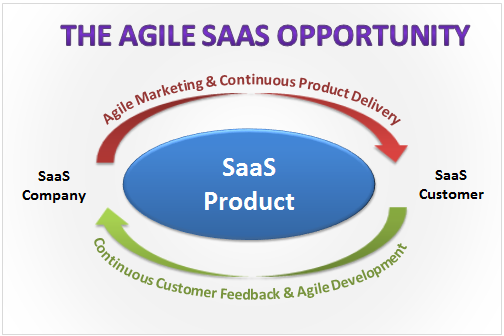I’ve been thinking a lot about how my SaaS experiences have shaped my thinking on agile management, and visa versa. SaaS and agile present complementary aspects that enable a uniquely symbiotic relationship. Agile aims to help businesses increase responsiveness to customer needs, while laying a foundation for continuous improvement. SaaS opens up real-time customer communication and product delivery channels, while simultaneously establishing a long term customer relationship. The high velocity at which SaaS customer value can be understood and then delivered through the SaaS product enables faster, more accurate fulfillment of SaaS customer needs to reduce SaaS churn and drive SaaS growth. IMHO, adopting and mastering agile software development, agile marketing and pretty much agile everything should be a priority of every SaaS business.
A Little Agile History
The roots of agile software development and agile marketing lie in agile manufacturing, lean manufacturing and total quality methodologies. The original total quality goals were very simple: increase quality and improve productivity. Two goals that were seen as opposite were made to be one. As global manufacturers mastered total quality, they upped their game and looked to increase responsiveness to customer needs, while maintaining productivity. Again, two goals that were seen as opposite were made to be one. This is the origin of agile.

Agile software development and agile marketing have followed similar, but unique paths. Buggy software, product delays and death marches were the norm in the 90s. A groundswell formed around the idea of taking the agile principles that had been so successful in manufacturing and applying them to software. Could we turn a death march that produces bugs into an efficient production line that produces quality software? In 2001, this culminated in the publishing of the Agile Software Manifesto. Since then, agile software development has become the industry standard.
Today, we are seeing a similar groundswell around agile marketing. The emergence of modern marketing as an essential revenue driver has led to high pressure performance, inflicting many marketing organizations with the same ills that plagued their pre-agile software engineering peers: too much work, too little time, and too little understanding in the rest of the organization of the work required to produce quality results.
The Forgotten Agile Customer
 As agile evolves and adoption expands throughout the SaaS sector, one thing concerns me greatly. What happened to the customer? The very first line of the principles behind the Agile Software Manifesto begins: “Our highest priority is to satisfy the customer…”, but all I ever hear is SCRUM, collaboration, backlogs, sprints, and story points. The voice of the customer has somehow been lost. On most agile development teams, a single ‘product owner’ represents the voice of the customer and must compete with CEOs, VPs and VCs to be heard.
As agile evolves and adoption expands throughout the SaaS sector, one thing concerns me greatly. What happened to the customer? The very first line of the principles behind the Agile Software Manifesto begins: “Our highest priority is to satisfy the customer…”, but all I ever hear is SCRUM, collaboration, backlogs, sprints, and story points. The voice of the customer has somehow been lost. On most agile development teams, a single ‘product owner’ represents the voice of the customer and must compete with CEOs, VPs and VCs to be heard.

There are three ideas at the center of any agile methodology.
- Customer-driven products and services enabled by real-time customer data
- Increased productivity from higher quality and reduced waste
- Iterative, continuous improvement over the long run
It is #1 that defines agile; #2 & #3 are borrowed from earlier methodologies. The overarching idea is that productivity and quality are table stakes, whereas real-time customer responsiveness creates sustainable competitive advantage in a fast-moving market. There are few markets moving faster than SaaS, but we are missing the agile SaaS opportunity. Agile is not SCRUM. Agile is not sprints. These are just means to the end. Agile SaaS aims to accelerate SaaS business growth increasing the velocity of value delivered to your SaaS customers.
Agile SaaS and the Velocity of Customer Value
We use the word ‘value’ alot in SaaS: lifetime customer value, average subscription value, total contract value, SaaS company value, and so on. However, we rarely use it in the agile sense of the word: customer value. Not the value of a SaaS customer to the SaaS business. Not the value of a SaaS business to its investors. The value a SaaS business delivers as judged by its SaaS customers.

Agile SaaS creates a continuous loop of customer feedback and product delivery:
listen, build, deliver…listen, build, deliver…etc., that responds rapidly
to SaaS customer needs, increases competitiveness and drives SaaS growth.
When we choose a feature off the backlog, publish a blog post or handle a support ticket, the opinion that counts in agile is the customer’s. Your SaaS customer must say it, read it, write it, click it, rate it, review it, share it, try it, buy it or recommend it to provide a measure of your work. It is a core competency of any agile SaaS business to collect, analyze, disseminate and act upon feedback from its customers. If your SaaS business has implemented agile software development or agile marketing, but it doesn’t have a continuous real-time flow of feedback from your customers indicating the value of your work, then you don’t really have agile.

On the other hand, you might be the most customer-focused SaaS business on the planet, but if you don’t have the ability to act on it faster than your competitors, then it will do you little good. An agile competitor can learn from your customers as well as its own, copying and improving whatever innovation you deliver before you have time to sell it. Agile SaaS businesses set up a continuous loop of customer feedback and product delivery: listen, build, deliver…listen, build, deliver…etc., that responds rapidly to the needs of their customers and keeps them ahead of the competition. The higher your velocity of value, the faster your SaaS business grows.
The Agile SaaS Opportunity
Imagine getting real-time SaaS customer feedback on your SaaS product on a daily basis. Your customers can rate, review, suggest, complain or ask for help from directly inside your product. Then, complement that with real-time product usage data and ongoing customer surveys. Then, expand that feedback beyond your product to everything you do from your blog to technical support. Now, imagine that information being accessible to everyone in your organization, not just a product manager or market researcher. Finally, imagine your teams using agile methods to take that feedback and turn it into new product releases, new marketing campaigns and new services in a matter of days and weeks as opposed to months and years. This is the Agile SaaS opportunity.
No other industry has the same intersection of intimate long-term customer relationships, potential automation of customer feedback and product delivery, and intense market competitiveness. No other industry has more capability to reap the benefits of agile or the need to do it. Does your SaaS business measure up to your agile imagination? Or, are you missing the opportunity of Agile SaaS?

Hi, few years after your vision is still very accurate !
I am currentlyy working on retrolution a SaaS tools helping agile team with their retrospective.
Lots of our customer are building SaaS products, deep rooter with agility in mind
Hi, thank you for this post I agree with you that Agile aims to help businesses increase responsiveness to customer needs while laying a foundation for continuous improvement. very useful information
Love this! We are SaaS and are constantly tempted by refusing customer feedback vs taking it into our agile process. But we always want to be more adaptive to feedback. Thanks!